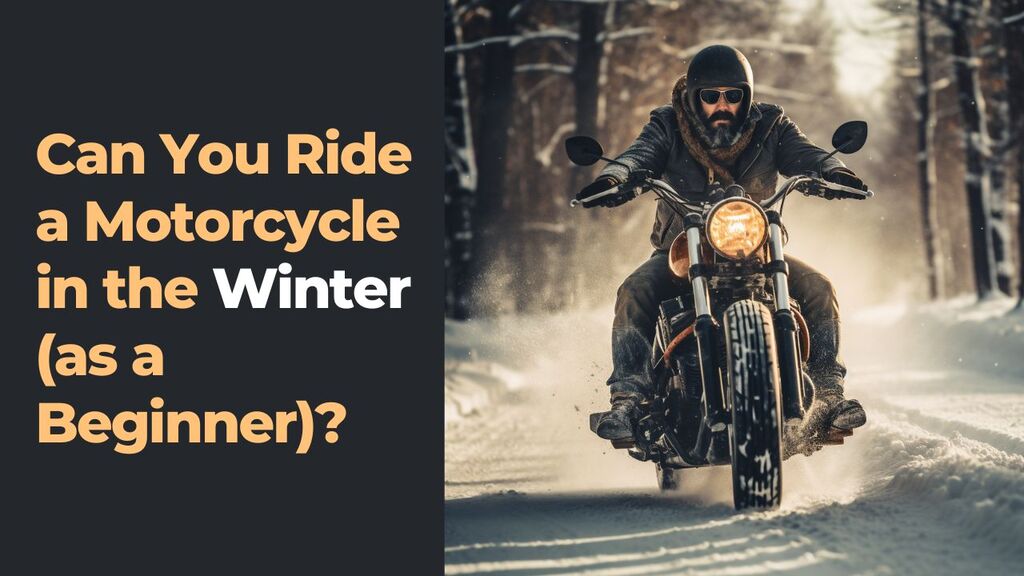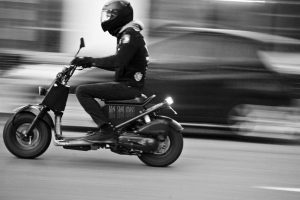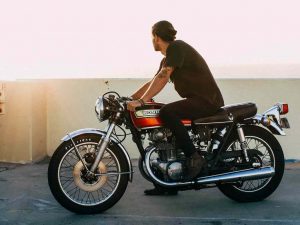Winter sure changes things up for us riders. The chilly temps and lousy road conditions add a whole new set of things to consider. Can you ride a motorcycle in the winter as a beginner? It takes some getting used to, for sure. But you know what they say – where there’s a will, there’s a way!
We’re all beginners at some point. These colder months are perfect for gaining skills, as long as we prepare properly and adjust how we ride. The key is bundling up tight, making our bikes ready to brave the elements, and focusing extra hard on footing and visibility. Riding smart is rule number one when Jack Frost is out.
KEY POINTS
- Proper clothing layers are essential – Wear a moisture-wicking base layer, insulating mid-layer, and waterproof/insulated outer shell. Make sure to cover all exposed skin.
- Adjust your riding style – Ride more slowly and cautiously. Allow extra braking distance and avoid slippery surfaces like ice and snow if possible.
- Prepare your bike – Check tire pressure regularly and use tires suitable for cold conditions. Thoroughly wash the bike after rides to prevent salt corrosion.
- Make use of heated gear – Electrically heated gloves, handguards, seats or handlebars can significantly improve comfort on long rides in very cold weather.
- Gain experience in warmer conditions first – Winter presents additional hazards, so it’s best to have 6+ months of warm weather riding experience before braving challenging conditions as a new rider. Proper preparation and adjusted riding skills are important for winter.
Can You Ride a Motorcycle in the Winter?
Folks sure do ask us: can you really ride a motorcycle through the winter? And our answer is yep, but it takes some work.
The cold itself ain’t no dealbreaker. We’ve all bundled up plenty over the years to prove that. It’s more the slippery roads and reduced visibility that make winter such a change.
That’s where preparation comes in. We spend extra time checking tire pressure, swapping to all-season rubber, and doing maintenance before the flakes fly.
Riding style shifts too – going slower, leaving big gaps, and avoiding any ice or snow patches. Wind and temps go right through you on the highway, so heated grips are a must.
At the end of the day, we do it because we love two-wheeling too much to put the bikes away three solid months a year.
Yeah, some days it ain’t too fun. But hitting the road on a sunny afternoon when it’s just above freezing, dodging the slush and feeling that chill in your lungs – man, is it worth it. It’s all about bundling up and riding smart.
How to Dress up for Winter Riding
Layering up is so important when we hit the road in colder months. The wind chill can really steal your body heat when you’re riding, so you need lots of insulation.
We always say “dress for the temperature, not the conditions” – it may be sunny out, but it’ll still feel like the dead of winter at 60 mph!
Choose Insulating Base Layers
Cotton is a no-no when it’s chilly – it does nothing to retain warmth when wet from sweat or road spray.
Instead, opt for base layers made from wool or synthetic materials like polyester. They draw moisture away from your skin so you stay dry and cozy. Fleece and long underwear are lifesavers for keeping warm underneath your outer layers.
Add an Insulating Mid Layer
A good mid layer, like a thermal shirt or sweater, traps air between the two layers and improves insulation. Fleece is a popular choice since it retains warmth even when wet.
On colder days, we like bulky down or synthetic puffer coats too. Give yourself room to layer, skin-tight clothes hamper air flow on long rides.
Top It Off with Waterproof Shell
Not only does a waterproof outer layer guard against rain, it also protects your warm inner layers from cold wind.
We don’t mess around with any shell lacking insulation. Go for waterproof and lined with fleece or another thermal material. Full zippers let you vent layers as needed without exposing yourself to chilly blasts.
Don’t Forget the Extras!
Neck tubes, balaclavas, and helmet liners stop those annoying drafts everywhere else. Heated gloves are clutch too – battery-powered hand warmers only last so long.
And don’t kid yourself, your feet get darn cold swinging those pegs in winter; boot warmer inserts are a godsend on freezing mornings. Just make sure any heated gear is waterproofed too!
With the right layering strategies, you’ll stay toasty and comfortable even on long rides in chilly weather.
Take it slow till your layers warm up, and don’t forget to stash extras in your saddlebags in case you need to add or remove a layer mid-ride.
Winter Bike Preparation and Maintenance
When temps drop, it’s time to give the old girl some extra love. We make sure she’s ready to brave the cold.
a. Check That Pressure
Tire pressure seems to drop faster in the cold. We always check them before any long ride. Nothing ruins a fun cruise like a flat from under-inflated rubber. It’s also worth keeping an eye on tread wear, slippery roads mean you want good grip.
b. Wash Away That Salt
Road salt is murder on a bike. After a wet ride, we make sure to hose her down good. The guy at the shop said leftover salt can cause rust even weeks later if you don’t rinse it off. We don’t want our girl getting sick from all that grit!
c. Consider Some Heated Comfort
Heated grips are awesome when your fingers get numb. And man, a heated seat makes long hauls so much cozier on frigid days.
Installation isn’t too tough, and it’s cheap peace of mind. We installed mine during fall maintenance; it’s great having that little boost of warmth on tap.
d. Check All Lights and Cables
Winter weather is tough on wiring and bulbs. When swapping tires, we took time to inspect everything.
Found a short in my main wiring harness from moisture, saved me from headaches down the road. It pays to be thorough when prepping for chilly months.
e. Stash Emergency Gear
We keep a space blanket, hat, gloves, and snacks in a backpack bungeed on. You never know when you might get stranded somewhere remote. Better safe than bundled in the trunk waiting for AAA!
Cold Weather Riding Techniques
When it’s chilly, we’ve got to adjust our skills a bit. Gotta keep ourselves safe!
a. Warm up Those Tires
We always spend a few minutes just puttering around the neighborhood before hitting the main roads. Cold tires don’t grip as well. Gotta get some heat in them so they’re sticky! Doesn’t take long if you’re moving.
b. Leave Extra Space
Braking distances increase big time when the temps drop. We give other vehicles lots more following room, since nobody’s reflexes are perfect in lousy weather. Can’t be too cautious.
c. Watch For Trouble
Visibility takes a hit with low sun and falling snow. Other drivers get lazy too. We sweep our eyes from side to side like mad, scanning well ahead through our corners. Don’t trust that nobody’s gonna do something dumb!
d. Take It Slip-Sliding Away
Black ice is no joke. We go slow and gentle through any shady spots on bridges. Tapping the rear brake eases us through slippery turns too. If things get hairy, roll off gently. No use whipping the handlebars around!
The road’s more treacherous than summer, so we pay extra attention on our rides. But taking it easy and using our heads keeps us riding safe in the cold months too.
Safety Considerations When Riding in Winter
Our main focus in winter is staying safe. We gotta keep extra risks top of mind.
a. Avoid Black Ice Like the Plague
If there’s even a doubt of icy patches, we give that road wide berth. Front wheels slipping out from underneath ain’t no joke. We all fell once learning – better not be at 50mph!
b. Watch for Lags in Attention
It’s darn hard staying focused when you’re freezing. We take more frequent breaks to get warmth flowing again. No sense pushing on half-alert just cause we’re tough – that’s how mistakes happen.
c. Don’t Get Caught Out Late
When the sky spits snow, we head for home or the nearest café. Roads changing fast in storms means trouble finding grip. Beating the front isn’t worth the risk of getting stranded out backroads side.
d. Look out for Fellow Riders
We look out for each other too. If someone’s shivering at the rest stop, we make sure they get in a truck with someone before taking off. They’ll do the same for us another time. Safety means monitoring your buds too in bad conditions like these.
FAQs About Can You Ride a Motorcycle in the Winter
Can I ride a sports bike in the winter?
Sports bikes without wind protection can be more challenging due to increased wind chill. Consider adding handguards or other wind deflection. Also be aware these bikes may have less storage for extra winter layers.
What’s the coldest temperature I can ride in?
Most experts say 32°F as an approximate minimum, but proper insulated clothing can expand this range. Layering is key – the ride may be fine, but stopping for any length brings rapid heat loss.
How do I store my bike over winter?
Store inside if possible with a battery tender. Otherwise, use a motorcycle cover and block the wheels. Check fluid levels and inflate tires before uncovering in spring.
What type of tires should I use?
All-season or winter tires offer improved traction on wet and icy roads vs. summer performance tires. Look for the mountain/snowflake symbol for true winter tires.
Any tips for riding in snow?
Most experts don’t recommend riding in snow. If you must, use a heated jacket, snow goggles, and winter tires – and ride only if conditions are clear with no accumulation.
How do I clean road salt off my bike?
Wash with water as soon after riding as possible. Pay extra attention to the underside, brakes and fasteners. Rinse frequently used areas like the brake fluid reservoir to prevent corrosion.




